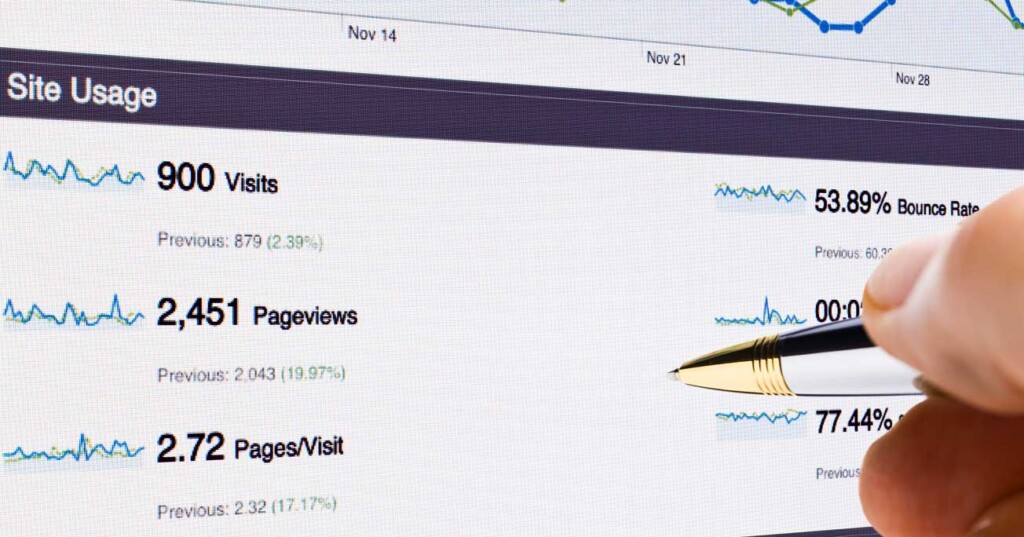
Will a Website Redesign Affect My Search Rankings?
Table of Contents
TLDR
A website redesign can lead to temporary search ranking fluctuations, and proper SEO implementation is crucial to minimise negative impacts and leverage the opportunity to improve organic search strategy and address pre-existing SEO issues.
Preserving the website’s URL structure, ensuring proper 301 redirects, and retaining high-ranking content is essential to maintaining SEO rankings throughout a redesign process.
Continuous monitoring using tools like Google Analytics and Webmaster Tools post-redesign is vital to measure success beyond search rankings, ensuring optimal user engagement and identifying areas for further optimisation.
Listen to the Article
The voice and reading of this article are provided with the use of AI.
Can Re-Designing a Website Affect My Search Rankings?

Are you wondering, ‘Will a website redesign affect my search rankings?’ Yes, it can, and this article explains how.
I have been building websites since the 1990s when you could only access the Internet through a modem that was so expensive to run that you used it sparingly. My experience spans revamping large enterprises to SMEs requiring an upgrade and startups beginning their journey.
Each project usually presents unique challenges, forcing me to adapt, innovate, and apply strategic SEO principles to ensure a seamless transition without sacrificing the site’s performance or user engagement.
A website redesign requires a thoughtful approach to SEO. During this transformative phase, you should equip yourself with the knowledge to maintain or improve your search ranking positions.
• • •
The Impact of Website Redesign on SEO

A website redesign significantly impacts SEO, often as a double-edged sword. On the one hand, it presents an opportunity to enhance site structure, improve user experience, and optimise content to make it relevant if out of date, improve its visibility or make it more helpful. On the other hand, it risks losing established search equity if not handled with SEO best practices.
You must consider maintaining URL integrity, implementing proper redirects, updating metadata, and ensuring mobile responsiveness. A well-executed redesign can maintain or increase rankings as well as user engagement, whereas oversight in SEO considerations can lead to a temporary or prolonged dip in search performance.
An improper redesign may decrease search engine rankings and visibility. This can lead to a loss of valuable traffic and conversion opportunities, affecting your bottom line.
Yet, positive changes can emerge from a well-implemented website redesign. Some benefits of a website redesign include:
- Higher SEO rankings
- Increased profitability
- Aesthetic enhancements
- Improved functionality
- A user-centric experience
A redesign period is also an opportune time to tackle existing SEO weaknesses and improve your organic search strategy.
Understanding Search Engine Reactions to Redesigns
Temporary fluctuations in search rankings are likely to result from website redesigns. Search engines need time to re-crawl and understand the new site structure, which can also impact search results.
However, these fluctuations should stabilise within a month or so, provided the redesign is executed correctly. It’s essential to factor SEO into your website redesign strategy to avoid significant traffic losses and a reduction in your online reputation.
The Role of URL Structure During Redesign
Your website’s URL structure plays a pivotal role during a redesign. Maintaining the same URL structure is vital for search engines to recognise the new website as a continuation of the previous one and to preserve search rankings. The URL structure communicates the website’s structure to search engines and influences the relevance of specific pages to search queries.
Changing the URL structure without proper redirects can have negative consequences, including:
- Confusing search engines, leading to a drop in search rankings
- Failing to inform search engines about the page’s new location
- Losing ranking in the search engine results
- A poor user experience
301 redirects are imperative to avoid these issues and ensure a smooth transition.
Content Preservation Strategies
Preserving high-ranking content is of the utmost importance. While starting from scratch with new brand messaging is tempting, retaining high-performing content helps maintain organic traffic and sustain inbound links and featured snippets.
High-ranking content should not be scrapped or revised without careful consideration. You should aim to retain core elements such as H1 and H2 tags, the main keywords a page ranks for, and optimise images with relevant file names and alt text, prioritise user intent when updating content during a website redesign.
• • •
Optimising Your Redesigned Site for Search Engines

Optimising your redesigned site for search engines is critical for maintaining and enhancing your SEO performance. Implementing search engine optimisation, maintaining the same URL structure, integrating on-page SEO features, and enhancing page speed can significantly improve search engine indexing.
Organising content to be relevant and easy to navigate can:
- Reduce bounce rates
- Enhance visitor retention
- Upgrade SEO
- Improve page load speeds and security
- Preserve site authority during the redesign
Aim to enhance user experience by implementing these strategies.
Technical SEO Considerations in Redesigns
It is necessary to prioritise technical SEO considerations. Speed optimisation, including code optimization, image compression, and file minification, aligns with Google’s ranking factor involving site speed. Moreover, a responsive design is critical for cross-device compatibility and meeting Google’s mobile-first indexing.
Facilitating effective crawlability for search engines is also crucial. This can be achieved by:
- Updating the XML sitemap
- Optimising the use of JavaScript, CSS and Minification
- Optimising new multimedia for SEO
- Ensuring URL optimisation
- Implementing canonical tags and proper robot files and tags
Data from device and technical settings in Google Analytics should guide these technical SEO considerations.
Aligning Content with Relevant Keywords
Your site should integrate relevant keywords. Therefore, start your keyword research at the start of a website redesign. This ensures that your content aligns with these keywords, improving your rankings.
Maintain content quality and relevance during the redesign to safeguard your site’s relevance in search queries and protect your rankings. Optimise your content by considering keyword choice, frequency, and placement, aligning with SEO best practices.
Enhancing User Experience for Better Rankings
To achieve better search rankings, enhancing user experience is vital. Attention to detail, like white space around text and titles, which increases user attention by 20%, significantly enhances content legibility and focuses on surrounding elements.
Additionally, ensuring that hyperlink differentiation through visual cues like underlined text and different colours makes links easily identifiable, encouraging user interaction. A consistent website design across web pages also improves the user experience by making navigation predictable.
• • •
Common SEO Pitfalls in Website Redesigns

Even with the best intentions, a website redesign can lead to SEO pitfalls. For instance, removing pages with high popularity, low bounce rates, and high conversions can negatively affect page rankings after a redesign. Ignoring URL structure continuity can also lead to losing established page authority and ranking.
Common SEO errors during redesigns include:
- Not setting up proper redirect structures
- Not retaining high-ranking content
- Incorrect content migration, which can lead to content loss, errors, and disruptions in content flow
Therefore, avoiding these potential pitfalls is crucial for a successful website redesign.
The Consequences of Broken Links
Known also as dead links, broken links can detrimentally impact SEO. They generate error messages like “404 Not Found” and may be viewed by search engines as a sign of poor quality or outdated content. Beyond SEO, broken internal links significantly affect user experience and the website’s credibility.
Search engines encountering broken links may spend less time indexing a website, ultimately affecting its visibility and search ranking. Regular checks for response code errors and implementing 301 redirects correctly are crucial steps to eliminate broken links and improve user experience and SEO.
Risk of Losing Inbound Links
During a redesign, losing inbound links, crucial for SEO, can harm your site’s backlink profile and authority. Analysing the ‘Links to Your Site’ section in the Google Search Console ensures valuable backlinks are maintained after a redesign; if you need to change a URL, add a 301 redirect to preserve the power of the backlink.
Retaining legacy URLs during a website redesign is essential for maintaining SEO rankings, as they carry an SEO reputation based on age, inbound links, and traffic history. Not keeping high-ranking content with priority keywords can result in traffic loss, reduced inbound links, and loss of featured snippets.
Overlooking Mobile Users
Your SEO performance can be negatively affected if mobile users are overlooked during a website redesign. Google penalises sites not optimised for mobile and only uses a mobile crawler to look at your pages. Affecting usability and search rankings. Google favours a mobile-first approach, making it essential for a site to perform well on mobile devices.
Creating a mobile-friendly site is recommended to provide mobile users with a seamless and positive experience. If search engines cannot effectively crawl the mobile version of a website, it can result in lower search rankings. There are three configurations for creating mobile-friendly sites: responsive design, dynamic serving, and separate URLs, with responsive design being the most straightforward to manage.
When creating articles like this, I have learned to preview them on mobile before desktop. Why ? It is simple: are the paragraphs too long, thereby creating walls of text? Is the text easily scalable with headings, bullet points, etc. Finally, how tired does my thumb get when scrolling down the page?
• • •
The Website Redesign SEO Checklist

The significance of a website redesign SEO checklist is paramount. Incorporating SEO from the start of a website redesign process can significantly increase visitors, leads, and sales. To maintain search rankings during a redesign, it’s essential to:
- Keep the same URL structure.
- Test all links
- Update content with care
- Optimise for page speed
Testing the new website ensures no unexpected issues on various devices and browsers, preserving SEO integrity. A common reason for SEO failures during website redesigns is the absence of planning and a clear SEO strategy, which the SEO checklist aims to prevent.
Conducting a Thorough SEO Audit
A thorough SEO audit is a crucial part of the website redesign process. Here are some critical metrics to assess:
- Ranking
- Traffic for important keywords
- Domain authority
- Total search traffic
- Revenue from organic searches
These metrics will help you understand the site’s current performance before redesigning. Benchmarking the pre-redesign site performance is essential to establish a comparison baseline, which will help identify whether post-redesign changes impact rankings and traffic.
Several tools can assist in conducting an SEO audit. Use site audit tools ( I prefer to use Screaming Frog and aHrefs) to uncover technical errors, SEO problems, and design or content issues that may affect the user experience. Catalogue existing URLs through an inventory to ensure that no valuable content or crucial URLs are lost during the redesign transition.
Prioritising Page Speed and Performance
Improving user experience and SEO largely depends on the page load speed. According to https://rankmath.com/blog/wordpress-speed-optimization/, a one-second delay in page response can result in a 7% reduction in conversions and over a 20% increase in bounce rates. To reduce page load times, you can:
- Optimise images
- Use browser caching
- Minimise code
- Consider server and hosting capabilities.
- Utilise content delivery networks (CDNs)
Implementing these strategies can improve your website’s performance and provide a better user experience.
Continuous performance monitoring is crucial to promptly identify and resolve speed issues, ensuring optimal performance across all user devices and platforms. Employ diagnostic tools such as Google PageSpeed Insights and Siteimprove Performance to analyse and track the website’s page speed, which aids in making data-driven optimisations.
Implementing Effective Redirect Strategies
To preserve SEO value and ensure users reach the right pages, implementing effective 301 redirect strategies during a redesign is crucial. A 301 redirect transfers 90-99% of the SEO value from the original page to the redirected page, maintaining the page and site authority post-redesign.
Setting up 301 redirects should be a priority in a website redesign to ensure old URLs point correctly to the new ones. To effectively implement 301 redirects during a website redesign, create a comprehensive list of all URLs to match old URLs to new ones, ensuring users and search engines are directed to the appropriate recent page locations.
• • •
Measuring the Success of Your Redesigned Website

The success of your redesigned website is measured by more than just your search rankings. It’s essential to:
- Evaluate bounce rates on entry pages
- Monitor repeat visitor numbers to measure visitor engagement and the redesigned website’s ability to retain visitors.
- Assess browsing sequences to identify and address navigation issues or usability flaws that may present after the redesign.
Review the conversion funnel to pinpoint potential exit points and improve steps towards conversion. Identifying top-performing site features such as compelling entry pages and elements that lead to conversions can help focus and align the redesign around these strengths, ensuring the redesign enhances rather than undermines them.
Utilising Google Analytics and Webmaster Tools
Utilising Google Analytics and Webmaster Tools can aid in monitoring and optimising the performance of your redesigned website. Benchmarking SEO performance before a redesign is crucial to identify if ranking changes post-redesign are due to the redesign or external factors. Browsing sequences and conversion funnels in Google Analytics provide insights on navigation paths and purchasing process drop-offs, guiding improvements in the redesign.
Visitor segmentation in Google Analytics helps identify the most valuable pages and features by pinpointing visits that lead to conversions. Setting up alerts in Google Search Console is necessary to remember manual actions by Google, signifying issues with the redesigned site that require attention. Monitoring Search Analytics in Google Search Console is imperative to track performance shifts in search queries, click-through rates, and impressions after a redesign.
Setting Up Performance Benchmarks
Setting up performance benchmarks can be helpful for gauge visitor engagement and the redesign’s impact on user actions. Review key performance indicators (KPIs) and analytics data to establish a baseline understanding of current site performance, traffic sources, and conversion issues. Set benchmarks related to conversions, such as the performance of calls-to-action (CTAs), marketing offers, and the effectiveness of landing pages, to measure the redesign’s impact on user actions.
Include bounce rate as a benchmark to gauge visitor engagement before and after the redesign. Employ the new to repeat visitors ratio as a benchmark to understand whether the redesign improves visitor retention and attraction.
Continuous Monitoring and Optimisation
After your website’s redesign, continuous monitoring and optimisation are vital. Here are some key areas to focus on:
- Regularly analyse user engagement, such as bounce rates and browsing patterns, to identify areas for improvement and optimise user experience.
- Monitor search rankings and organic traffic to ensure the redesign does not negatively impact your website’s visibility.
- Assess device and technical settings usage to identify any issues or areas for improvement.
- Based on the data and feedback you gather, make iterative improvements to optimise your website design and continuously cater to all users.
Continuous performance optimisation initiatives are necessary to accommodate updates in technology and evolving user expectations for fast loading times.
• • •
In Summary

A website redesign can significantly impact your SEO – positively if executed right or negatively if not. Proper planning, incorporating SEO from the start, maintaining URL structure, preserving high-ranking content, optimising for speed, and continuous monitoring and optimisation are all critical for a successful website redesign. Remember, your redesigned website should not only look good but should also perform even better.
Frequently Asked Questions
What are the disadvantages of website redesign?
The disadvantages of website redesign include alienating your target audience if the appropriate measures are not taken to reach the right people. It’s important to consider how changes may affect your audience.
Does website design impact SEO?
Yes, website design does impact SEO. A well-planned and executed web design will improve search engine optimization and the user experience.
Will I lose Google ranking if I redesign or redevelop my website?
Yes, redesigning or relaunching your website can impact your Google ranking and SEO efforts. It is essential to proceed with caution to avoid any negative consequences.
How can I maintain my search rankings during a website redesign?
To maintain your search rankings during a website redesign, keep the same URL structure, thoroughly test all links, update content cautiously, and optimise for page speed. This will help preserve your current rankings and avoid potential setbacks.
How can I measure the success of my redesigned website?
You can measure the success of your redesigned website by evaluating bounce rates on entry pages, monitoring repeat visitor numbers, assessing browsing sequences, and reviewing the conversion funnel. These metrics will provide valuable insights into the effectiveness of your website redesign.





